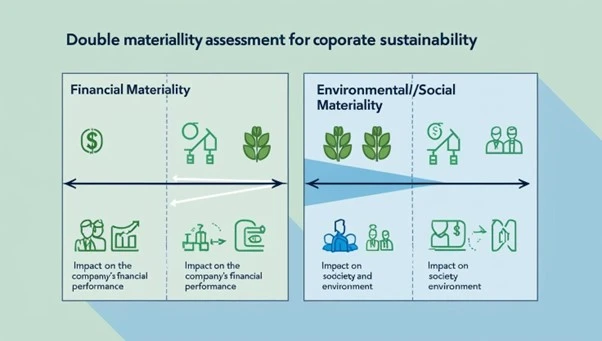
Synopsis:
What does double materiality mean in the context of ESG and sustainability?
What is the double materiality
Difference between single materiality and double materiality
Double materiality Assessment In CSRD
Way to implement double materiality assessment
Why is double materiality important?
What is the double materiality in ESRS?
Introduction:
In recent years, across the world many countries pay more attention to climate change as well as global warming.
By contrast, numerous businesses are accustomed to affecting the environment by their business activities. So, double materiality concepts have become more prominent in modern businesses.
Traditional materiality concepts focus solely on financial risk, while double materiality focuses on both areas.
Because of sustainability and financial challenges, double materiality has become increasingly necessary in ESG business.
Although necessary, many entities are not able to align the process due to the several challenges such as data consolidation data consolidation, different regulatory requirements, and more.
What does double materiality mean in the context of ESG and sustainability?
To understand double materiality perfectly, we must first comprehend traditional materiality concepts.
Traditional materiality focuses solely on addressing organization-based financial issues. If an organization relentlessly exploits our natural resources for profit, it can lead to environmental disaster. By focusing solely on financial gain without considering environmental impact, an organization paves the way for natural disasters.
To prevent and protect the environment, the double materiality concept is introduced in ESG and sustainability. Through double materiality, organizations can build better sustainability strategies and efficiently create sustainability reports.

What is double materiality?
Double materiality focuses on both financial impact and societal materiality. Entities are required to report on both metrics. It emphasizes that organizations must understand their responsibility towards the environment and be prepared for environmental issues to ensure the availability of natural resources for future generations. Moreover, through double materiality, investors and stakeholders gain a transparent view of an organization's business operations.
- Societal Impact: This represents how environmental and natural resources are affected by an organization's business activities.
- Financial Impact: This represents how an organization's financial performance and decision-making are affected by ESG issues.
Difference between single materiality and double materiality:
- Single Materiality: Focuses solely on financial risks and their impact on the organization's financial performance.
Double Materiality Assessment in the CSRD
The Corporate Sustainability Reporting Directive (CSRD) was introduced by the European Union. It insisted on more comprehensive details in reporting. Under the CSRD framework, companies should incorporate double materiality in ESG or sustainability annual reporting.
Double materiality under the CSRD implies that companies should address and evaluate both financial impact and environmental impact. This approach can achieve transparency in ESG reporting and encourage responsibility.
For example:
- In other words:
- How entities affect the environment.
- How the environment is affected by entities' activity.
Ways to Implement Double Materiality Assessment
To implement double materiality in business, entities should understand financial impact along with societal materiality
Define organization goal:
If entities would like to adopt materiality concepts in business, they must comply with the CSRD. So that, the entity should understand the goal accurately.
For example:- Why is it needed?
- What are we going to achieve from that?
Stakeholders:
In material sustainability, Stakeholder considerations are the primary matter.
To execute double materiality assessment, stakeholder engagement is a must. Each perspective is different. External stakeholders identify and highlight which environmental metrics are affecting the society.
With the help of key stakeholders, entities have to profoundly discuss the organization's environmental operations and collect their feedback too.
For example:
External stakeholders are easily mentioned, if water, land, air are affected due to the organization's operations. They might raise concerns about that.
Secondary Stakeholders or Internal Stakeholders:
With the help of internal employees, we can understand how sustainability affects financial performance.
For example:
If organizations produce excess emissions, it might cause increased taxes.
So, connect various stakeholder opinions and address the issues.
Identify the issue or topic:
- Gather insights from internal employees and investors.
- Gather insights from customers, NGOs, and regulators.
- Through the report, understand which sustainability metrics affect the operation.
- Evaluate the entire value chain and precisely identify which metrics are affecting the environment.
- Check and ensure industry-specific benchmarks.
- Using materiality frameworks, evaluate materiality topics much better.
Mapping the topic:
Consolidate all the insights. Once you gather all information regarding impact materiality and financial materiality, assess the factors.
Through the mapping, it is easy to identify and analyze the impact, risks, and opportunities in business operations.
- Environmental impact: Discover which metrics have a more positive than negative impact.
- Opportunities: Through opportunities, improve the performance in business operations for long-term financial success.
- Risk analyses: Evaluate the risks in business operations.
Chronologically prioritize issues:
Based on the analysis, pay more attention to critical sustainability issues and find out solutions to address them.
Incorporate into the business strategy:
Incorporate the identified material issues into the overall business strategy and decision-making processes.
What is double materiality assessment?
Double materiality assessment is a comprehensive evaluation of an organization's sustainability and ESG issues, considering both their financial implications and their impact on the environment, including climate change risk, energy risk, and regulatory compliance.
Why is double materiality important?
- Investors: To attract potential investors, double materiality is vital for the business.
- Risk management: Identifying environmental risks in business operations helps prevent environmental fines and reputational damage.
- Build potential transparency: With the help of double materiality, entities can easily identify issues and build enhanced ESG reports. Impeccable ESG reports lead to increased transparency. Through impeccable ESG reports, investors easily understand the organization's ESG performance as well as financial performance. This transparency also helps to attract potential investors.
- Advantage: An organization that adopts double materiality in business can build a strong organizational reputation. Furthermore, it can increase consumer loyalty.
- Social responsibility: Organizations should contribute substantially to future generations for a better livelihood.
- Regulatory compliance: Across the world, many countries are introducing stringent environmental rules such as carbon emission management and waste management. An organization that adopts double materiality can avoid legal fines.
Materiality concept

For instance, how can an audit organization finance without proper data? So, the materiality concept insists that financial information must provide proper information to users.
The materiality concept is essentially about preparing impeccable financial statements.
What is double materiality in the ESRS?
Double materiality in the European Sustainability Reporting Standards (ESRS) provides a comprehensive picture of an organization's sustainability performance, considering sustainability issues from both perspectives:
- How the organization's business activities affect the environment and society.
- How environmental, social, and governance factors affect the organization's financial performance.
To sum up:
Single materiality previously focused on a single perspective in sustainability Reporting. In other terms, the organization was focusing only on profit without considering any environmental effects.
Therefore, double materiality became necessary for businesses. It focuses on a double perspective: both internal and external factors.
Therefore, adopting double materiality software helps you build sustainability reports based on industry and geography.

